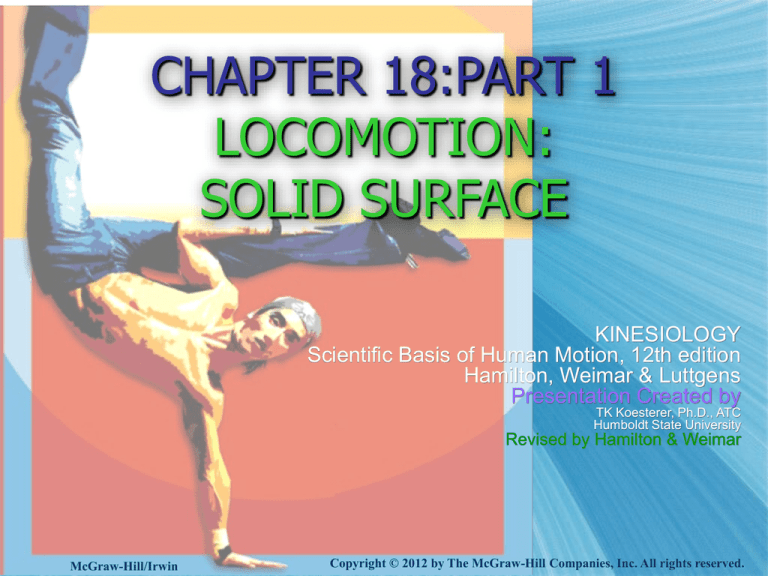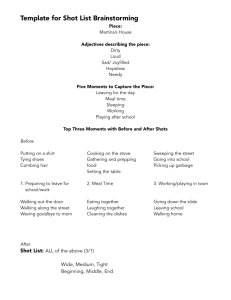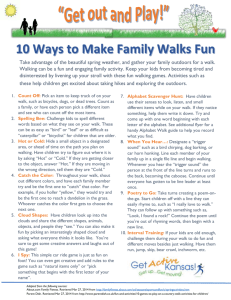
CHAPTER 18:PART 1
LOCOMOTION:
SOLID SURFACE
KINESIOLOGY
Scientific Basis of Human Motion, 12th edition
Hamilton, Weimar & Luttgens
Presentation Created by
TK Koesterer, Ph.D., ATC
Humboldt State University
Revised by Hamilton & Weimar
McGraw-Hill/Irwin
Copyright © 2012 by The McGraw-Hill Companies, Inc. All rights reserved.
Objectives
1. Identify and classify motor skills under the
heading of moving the body on the ground
or other resistant surface.
2. Describe the anatomical and mechanical
nature of the major locomotor patterns.
3. Name and state anatomical and mechanical
principles that apply to locomotor patterns.
4. Evaluate the performance of major
locomotor patterns.
5. Analyze the performance of a locomotor
skill.
18A-2
LOCOMOTION
The act or power of moving from place to
place by means of one’s own mechanisms or
power.
In the human being, it is the result of the
action of body levers propelling the body.
Ordinarily by lower extremities.
Occasionally by all four extremities.
Sometimes by upper extremities alone.
18A-3
WALKING
Description
Alternating action of the
two lower extremities.
Translatory motion of the
body brought about by
angular motion of some
of its parts.
Two phases:
Swing
Support
Fig 18.1
18A-4
WALKING
Description
Kinematics are often described in terms of
strides and steps.
Stride: from heel strike to the next heel strike
of the same leg.
Stride length: distance covered in one stride.
Step: from heel strike of one leg to heel strike
of opposite leg.
18A-5
WALKING
Description
Chief sources of motion in the swing
phase are gravity & momentum; ballistic
movement
Sources of motion for support phase:
1st Half: momentum of forward moving
trunk.
2nd Half: contraction of extensor muscles of
supporting leg.
18A-6
WALKING
Anatomical Analysis
Major Components of Walking
1. Pelvic rotation
2. Pelvic tilt
3. Knee flexion
4. Hip flexion
5. Knee and ankle interaction
6. Lateral pelvic displacement
18A-7
WALKING
Anatomical Analysis
Figure 18.2
18A-8
WALKING
Anatomical Analysis:Swing Phase
Spine and Pelvis:
1. Movements: Rotation of pelvis toward the
support leg and of spine in the opposite
direction; slight lateral tilt of pelvis toward
swing leg.
2. Muscles: Semispinalis, rotatores, multifidus,
and external oblique abdominals on side
toward which pelvis rotates.
Erector spinae and internal oblique abdominals on
opposite side.
Psoas & quadratus lumborum support pelvis of
swinging limb.
18A-9
WALKING
Anatomical Analysis:Swing Phase
Hip:
1. Movements: Flexion; outward rotation;
adduction at beginning and abduction at
the end of phase.
2. Muscles: Iliopsoas is prime mover of hip.
Assisted by rectus femoris, sartorius,
gracilis, adductor longus and pectineus.
18A-10
WALKING
Anatomical Analysis:Swing Phase
Knee:
1. Movements: Flexion during 1st half; extension
during 2nd half.
2. Muscles: Quadriceps extensors contract
slightly at end of phase.
Sartorius & short head of biceps femoris chiefly
following toe off.
Largest contributor is gravity when the knee
extensors relax at toe-off.
18A-11
WALKING
Anatomical Analysis:Swing Phase
Ankle and Foot:
1. Movements: Dorsiflexion; prevention of
plantar flexion.
2. Muscles: Tibialis anterior, extensor
digitorum longus, extensor hallucis longus,
and peroneus tertius (slight to moderate
intensity at beginning of swing phase,
taper off during middle portion of phase).
Contract again to prepare for heel strike.
18A-12
WALKING
Anatomical Analysis:Support Phase
Spine and Pelvis:
Rotation of pelvis toward same side and spine
to opposite side; lateral tilt away from support
leg.
Lumbar portion of erector spinae contracts at
heel strike to stiffen spine for support.
18A-13
WALKING
Anatomical Analysis: Support Phase
Hip:
1. Movements: Extension through foot flat to toe
off.
Reduction of outward rotation.
Followed by slight inward rotation.
Prevention of adduction of the thigh and dropping
of pelvis to opposite side.
2. Muscles: During heel strike gluteals and
hamstrings contract statically (moderate
intensity), taper off during foot flat and
disappear at midstance.
Only muscles active during last part of phase adductor magnus, longus, and brevis.
18A-14
WALKING
Anatomical Analysis:Support Phase
Knee:
1. Movements: Slight flexion from heel strike to
foot flat, extension from midstance until heel
lift.
2. Muscles: Quadriceps contract moderately in
early part of phase, then gradually relax.
Vastii contract throughout the 1st half of this
phase.
Hamstrings at the end of phase.
18A-15
WALKING
Anatomical Analysis:Support Phase
Ankle and Foot:
1. Movements: Slight plantar flexion
followed by slight dorsiflexion.
Prevention of further dorsiflexion.
Plantar flexion of ankle and
hyperextension of metatarsophalangeals
at end of propulsive phase.
18A-16
WALKING
Anatomical Analysis: Support Phase
Ankle and Foot:
2. Muscles:
Tibialis anterior, extensor digitorum longus and
hallucis longus early in phase.
Gastrocnemius and soleus active from midstance
to heel off.
Tibialis posterior middle part of phase.
Flexor digitorum longus (slight) in middle portion
of phase, moderate in the last portion.
Toe and intrinsic muscles respond to pressure of
ground against toes.
18A-17
Action of Upper Extremities
in Walking
Arms tend to swing in opposition to the legs.
This reflex action is usually without obvious
muscular action and serves to balance
rotation of the pelvis.
Maximum flexion of shoulder and elbow
occurs at heel strike of opposite foot.
Maximum extension of shoulder and elbow
occurs at heel strike of same foot.
18A-18
Neuromuscular Considerations
Walking relies heavily on reflex.
Reflexes also control movements of
supporting limb and trunk in resisting
the downward pull of gravity.
Stretch reflex: at extremes of motion.
Extensor thrust reflex: may facilitate the
extensor muscles of lower extremity as
weight rides over the foot on the support
leg.
18A-19
Anatomical Principles
in Walking
1. Alignment
a) Reduces friction and decreases the likelihood of
strain and injury.
b) Stability of weight bearing limb and balance of
trunk over this limb are factors in smoothness of
gait.
2. Unnecessary lateral movements decrease gait
economy.
a) Excessive trunk rotation with excessive arm
motion.
b) Pelvis may drop on one side without support.
c) Pelvic rotation should be just enough to enable
the leg to move straight forward.
18A-20
Anatomical Principles
in Walking
3. Normal flexibility of the joints reduces
resistance.
a) Tendons of two joint muscles of lower extremity
contribute to economy of muscular action in
walking.
4. Properly functioning reflexes contribute to a
well coordinated, efficient gait.
a) Injury, disease, or substance abuse can interfere
with the walking reflexes.
18A-21
Mechanical Analysis
Translation of the body’s center of gravity
forward as a result of the alternating pattern
of lower extremity joint movements during
the stance and swing phases.
Forces that control walking are;
External forces of weight, normal reaction, friction,
air resistance.
Internal muscular forces.
Direction & interaction of these forces
determine the nature of the gait.
18A-22
Mechanical Principles in Walking
1. Inertia of the body must be overcome with
every step.
2. A brief restraining action of the forward limb
serves as a brake on the momentum of the
trunk so as not to move the center of gravity
beyond the new base of support.
3. Translatory movement is achieved by
alternating the lower extremity angular
motion between the foot (support) and hip
(swing) (inverted pendulum).
18A-23
Mechanical Principles in Walking
4. The vertical component of ground reaction
force serves to counteract the pull of gravity.
The horizontal component serves to:
check forward motion during heel strike.
produce forward motion during toe off.
5. Speed is increased by increasing stride
length, stride rate, or both.
6. Speed is directly related to magnitude of
force and direction of application.
18A-24
Mechanical Principles in Walking
7. Efficiency of locomotion partially depends on
friction and ground reaction force.
8. Most efficient gait is one that is timed to
permit pendular motion of the lower
extremities.
9. Alternating loss and recovery of balance.
10. Lateral distance between feet is a factor in
lateral stability, with average step width at ~
10% of leg length.
18A-25
Walking Variations:
Individual Variations in Gait
Variations may be structural or functional.
Structural: body proportions & limb differences.
Functional: personality characteristics.
Pathological : disease, injury, or deformity
may produce deviations.
Age: decreases in strength and flexibility.
Balance becomes a concern.
Obesity: increased impact but smaller
propulsive forces.
Medial and lateral forces increase.
18A-26
Walking Variations:
Stairs & Ramps
Up stairs or a ramp: Forward lean of body to
direct the push of legs through the body’s
center of gravity.
Swing phase has exaggerated knee lift and
dorsiflexion of the ankle.
Down stairs or a ramp: Eccentric contraction
of muscles to lower body at a controlled rate
and maintain line of gravity toward back of
the base of support.
Swing phase has a slight lifting of rear foot to clear
the step.
18A-27
Walking Variations:
Race Walking
Adaptations to produce maximum
speed.
Must show a period of double support.
Minimizes double support period;
Increasing stride rate.
Decreasing stride length.
18A-28








